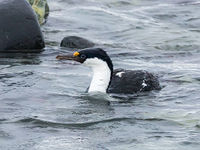Antarctic Shag
 From Conservapedia
From Conservapedia | Antarctic shag | |
|---|---|

| |
| Scientific classification | |
| Kingdom Information | |
| Domain | Eukaryota |
| Kingdom | Animalia |
| Subkingdom | Bilateria |
| Branch | Deuterostomia |
| Phylum Information | |
| Phylum | Chordata |
| Sub-phylum | Vertebrata |
| Infraphylum | Gnathostomata |
| Class Information | |
| Superclass | Tetrapoda |
| Class | Aves |
| Sub-class | Neornithes |
| Order Information | |
| Order | Suliformes |
| Family Information | |
| Family | Phalacrocoracidae |
| Genus Information | |
| Genus | Leucocarbo |
| Species Information | |
| Species | L. bransfieldensis |
| Synonyms | Phalacrocorax bransfieldensis Leucocarbo bransfieldensis atriceps |
| Population statistics | |
| Population | 26,700 (2018 est.)[1] |
The Antarctic shag (Leucocarbo bransfieldensis) is a species of cormorant of the family Phalacrocoracidae, and found on several islands of the Antarctic peninsula. Of uncertain taxonomic status and depending on the authority, it is treated as a species in its own right, or as a subspecies of the imperial shag, Leucocarbo atriceps[2].
Contents
- 1 Description
- 2 Range and habitat
- 3 Reproduction
- 4 References
Description[edit]
The Antarctic shag is medium-sized, about 28 to 31 inches long, a wingspan of 48.8 inches, and weighs 4.0 to 7.7 pounds. Females are slightly larger than males. It is black in color above, white below, with light orange, webbed feet, a pair of orange-yellow nasal knobs, and a small, erectile crest on its forehead. Like the imperial shag, it has a ring of blue skin around the eyes. The difference between the two species, as well as the other species of related cormorants collectively named "blue eyed shags", is largely superficial, with a ready identification marker the amount of white on the cheeks.
Range and habitat[edit]
This species is found in the South Shetland Islands to roughly 68o south on the Antarctic peninsula[3], the southernmost of any cormorant species. It is a marine coastal bird, never far from land when hunting for its prey at sea; when seen feeding it is found in groups of up to a hundred or more birds called "rafts".
Reproduction[edit]
Antarctic shags breed on top of cliffs and rocks in conical nests or flattened heaps of seaweed, moss, grass, guano, and mud. Females lay 2 to 3 eggs in October or November which are incubated by both parents for up to five weeks. Chicks are hatched without a coat of down, and are especially dependent on the parent birds as a result. Chicks become independent after 40 to 45 days.
References[edit]
- ↑ https://www.researchgate.net/publication/322799994_Population_status_of_the_Antarctic_shag_Phalacrocorax_atriceps_bransfieldensis
- ↑ http://datazone.birdlife.org/species/factsheet/phalacrocorax-bransfieldensis
- ↑ https://www.coolantarctica.com/Antarctica fact file/wildlife/blue_eyed_shags.php
Categories: [Birds] [Cormorants]
↧ Download as ZWI file | Last modified: 02/23/2023 06:37:48 | 46 views
☰ Source: https://www.conservapedia.com/Antarctic_shag | License: CC BY-SA 3.0
 ZWI signed:
ZWI signed: KSF
KSF